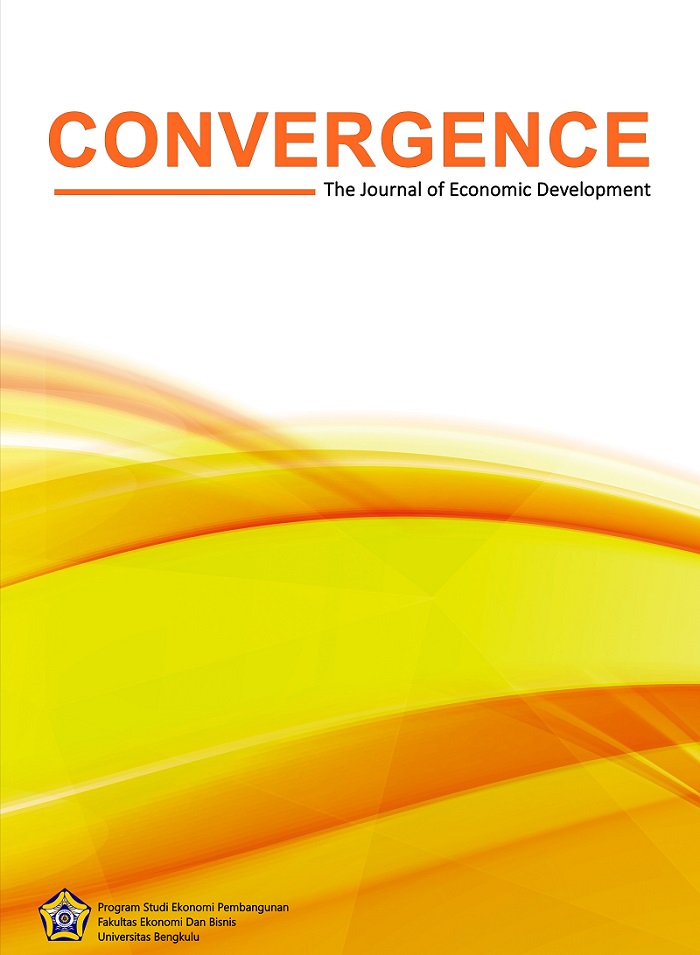Main Article Content
Abstract
This research aim was to analized the development disparities in Bengkulu Province, and the position change of 3 parent districts. The analysis method used descriptive anylisis with Klassen Typology and Williamson Index (WI), and used data from BPS Bengkulu Province publication (2002-2016). The result show WI for 2002, 2007 and 2016 in a row amount to 0,34; 0,40 and 0,37; which mean that the area expantion may cause the development disparities more equal or not. In the years of observation, position of 3 parent disticts always changing in the regional stucture of Bengkulu Province. It may caused of the dinamic development of the district, both parent and new districts.
Keywords : Development Disparities 1, Area Expansion 2, Klassen Typology 3, Williamson Index 4
Keywords
Article Details
- This statement is a commitment from the author, to respect copyright, both in terms of quoting the work of others, as well as in the use of journal content.
- If needed, the author can send a statement of authenticity of the manuscript. With the receipt of an article by the Editor of Convergence: The Journal of Economic Development, the article submitted has the copyright held by Convergence: The Journal of Economic Development Convergence:
- The Journal of Economic Development has the right to reproduce and distribute articles that have been published in journals.
- The author is not permitted to publish the same article that has been published in this journal.
References
- Adisasmita. R. (2008). Pengembangan Wilayah Konsep dan Teori. Edisi Pertama. Yogyakarta: Graha Ilmu.
- Armstrong. H.. & Taylor. J. (2001). Regional Economics and Policy. 3th edition. UK. Blackwell Publisher.
- Arsyad. L. (1999). Ekonomi Pembangunan. Edisi Keempat. Yogyakarta: STIE YKPN.
- Arsyad. L. (2005). Pengantar Perencanaan dan Pembangunun Ekonomi Kabupaten/kota. Edisi Kedua. Yogyakarta: BPFE-UGM.
- Bappenas & UNDP. (2008). Studi Evaluasi Dampak Pemekaran Daerah 2001-2007. BRIDGE
- BPS. (2018). Provinsi Bengkulu dalam Angka 2018. Bengkulu: Badan Pusat Statistik Provinsi Bengkulu. www.bengkulu.bps.go.id
- BPS. (2017). Tinjauan PDRB Kabupaten/Kota Provinsi Bengkulu 2014-2016. Bengkulu: Badan Pusat Statistik Provinsi Bengkulu. www.bengkulu.bps.go.id
- BPS. (2008). Provinsi Bengkulu dalam Angka 2008. Bengkulu: Badan Pusat Statistik Provinsi Bengkulu. www.bengkulu.bps.go.id
- BPS. (2003). Provinsi Bengkulu dalam Angka 2003. Bengkulu: Badan Pusat Statistik Provinsi Bengkulu. www.bengkulu.bps.go.id
- Bendavid-Val. A. (1991). Regional and Local Economic Analysis for Practitioners. 4th edition. Praeger.
- Blakely. E. J. & Bradshaw. T. K. (2002). Planning Local Economic Development: Theory and Practice. 3rd edition. USA: Sage Publications.
- Herawati, N. R. Pemekaran Daerah di Indonesia. http://ejournal.undip.ac.id
- Hoover. E.M. & Giarratani. F. (1984). An Introduction to Regional Economics. 3th edition. New York: Alfred A. Knopf.
- Kuncoro. M. (2003). Metode Riset untuk Bisnis dan Ekonomi: Bagaimana meneliti & menulis tesis?. Jakarta: Erlangga.
- Kuncoro. M. (2012). Perencanaan Kabupaten/kota (Bagaimana Membangun Ekonomi Lokal. Kota dan Kawasan?). Jakarta: Salemba Empat.
- Undang Undang No 3 Tahun 2003 tentang Pembentukan Kabupaten Muko-muko. Kabupaten Seluma dan Kabupaten Kaur di Provinsi Bengkulu.
- Undang Undang No 39 Tahun 2003 tentang Pembentukan Kabupaten Lebong dan Kabupaten Kepahiang di Provinsi Bengkulu.
- Undang Undang No 24 Tahun 2008 tentang Pembentukan Kabupaten Bengkulu Tengah di Provinsi Bengkulu.
- Widodo. T. (2006). Perencanaan Pembangunan: Aplikasi Komputer (Era Otonomi Kabupaten/kota). Yogyakarta: UPP STIM YKPN.
References
Adisasmita. R. (2008). Pengembangan Wilayah Konsep dan Teori. Edisi Pertama. Yogyakarta: Graha Ilmu.
Armstrong. H.. & Taylor. J. (2001). Regional Economics and Policy. 3th edition. UK. Blackwell Publisher.
Arsyad. L. (1999). Ekonomi Pembangunan. Edisi Keempat. Yogyakarta: STIE YKPN.
Arsyad. L. (2005). Pengantar Perencanaan dan Pembangunun Ekonomi Kabupaten/kota. Edisi Kedua. Yogyakarta: BPFE-UGM.
Bappenas & UNDP. (2008). Studi Evaluasi Dampak Pemekaran Daerah 2001-2007. BRIDGE
BPS. (2018). Provinsi Bengkulu dalam Angka 2018. Bengkulu: Badan Pusat Statistik Provinsi Bengkulu. www.bengkulu.bps.go.id
BPS. (2017). Tinjauan PDRB Kabupaten/Kota Provinsi Bengkulu 2014-2016. Bengkulu: Badan Pusat Statistik Provinsi Bengkulu. www.bengkulu.bps.go.id
BPS. (2008). Provinsi Bengkulu dalam Angka 2008. Bengkulu: Badan Pusat Statistik Provinsi Bengkulu. www.bengkulu.bps.go.id
BPS. (2003). Provinsi Bengkulu dalam Angka 2003. Bengkulu: Badan Pusat Statistik Provinsi Bengkulu. www.bengkulu.bps.go.id
Bendavid-Val. A. (1991). Regional and Local Economic Analysis for Practitioners. 4th edition. Praeger.
Blakely. E. J. & Bradshaw. T. K. (2002). Planning Local Economic Development: Theory and Practice. 3rd edition. USA: Sage Publications.
Herawati, N. R. Pemekaran Daerah di Indonesia. http://ejournal.undip.ac.id
Hoover. E.M. & Giarratani. F. (1984). An Introduction to Regional Economics. 3th edition. New York: Alfred A. Knopf.
Kuncoro. M. (2003). Metode Riset untuk Bisnis dan Ekonomi: Bagaimana meneliti & menulis tesis?. Jakarta: Erlangga.
Kuncoro. M. (2012). Perencanaan Kabupaten/kota (Bagaimana Membangun Ekonomi Lokal. Kota dan Kawasan?). Jakarta: Salemba Empat.
Undang Undang No 3 Tahun 2003 tentang Pembentukan Kabupaten Muko-muko. Kabupaten Seluma dan Kabupaten Kaur di Provinsi Bengkulu.
Undang Undang No 39 Tahun 2003 tentang Pembentukan Kabupaten Lebong dan Kabupaten Kepahiang di Provinsi Bengkulu.
Undang Undang No 24 Tahun 2008 tentang Pembentukan Kabupaten Bengkulu Tengah di Provinsi Bengkulu.
Widodo. T. (2006). Perencanaan Pembangunan: Aplikasi Komputer (Era Otonomi Kabupaten/kota). Yogyakarta: UPP STIM YKPN.
